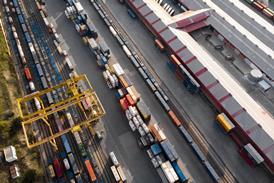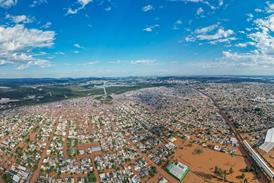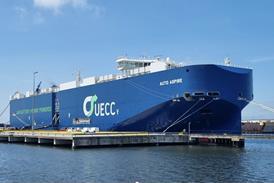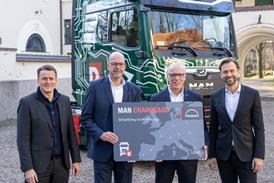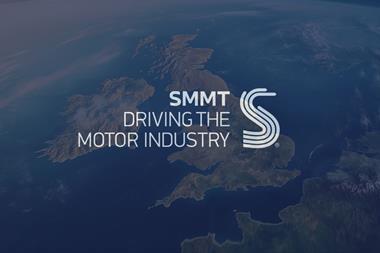Subaru has doubled sales in the US over the past five years, by maintaining a well-planned, stable scheduling and logistics flow. Its top logistics team talks in depth about the carmaker's strategy for current and future growth
Subaru has been on a tear for the last seven, tumultuous years in the US. Sales rose from 187,200 vehicles in 2007 to 425,000 in 2013 and are up another 20% so far this year. Gerald Lee, vice-president of vehicle planning and logistics for Subaru of America – the national sales and marketing company – believes it will surpass 500,000 units this year.
With production maxed at its plant in Lafayette, Indiana, a surge in import sales has reshaped the network, with Subaru of America adding ports, road hauliers and railway ramps. In 2011 it opened the port of Richmond, California as a supplement to Vancouver, Washington on the west coast, and last year it included Brunswick, Georgia as a second east coast gateway to Baltimore, Maryland. (Subaru has two independent distributors in the northeast – Subaru Distributors and Subaru of New England – that use the ports of Boston, Massachusetts and Davisville, Rhode Island.)It is also expanding production capacity at Lafayette, where Toyota (a 16% shareholder in Fuji Heavy Industries, Subaru’s owner) also produces Camry models, but is slated to leave the plant by 2017. At that point, Subaru-only capacity could exceed 400,000 units compared to 250,000 today, an increase likely to change its logistics further, particularly with more rail destinations from the plant. Subaru is already adding tracks at the plant’s rail yard – the second such expansion in three years – to increase slots by 24 to 69, according to logistics planning manager Mike Lupacchino. When Toyota leaves, it will gain another 33 slots.
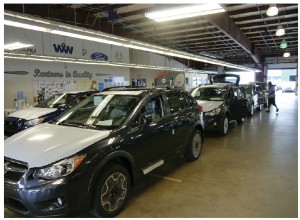
Bringing stability to scheduling and suppliers
Subaru now ranks among the top ten selling brands in the US, ahead of the Volkswagen division and behind Kia. However, the company’s corporate management team operates as a niche brand in some ways. Subaru’s supply chain resembles a more premium marque, including a high proportion of customer-sold orders and a low ground inventory. Logistics is designed for flexibility, including a strong mix between rail and long-haul trucking.
The company has a particularly agile touch for vendor relations and stable volume planning. While many carmakers have adapted the Japanese principle of heijunka, or ‘smoothing’, to level out production, few apply it to distribution in the way Subaru does. In an industry where the financial calendar encourages disproportionate volume in the last week of a month or quarter, Gerald Lee and his team take pride in spreading Subaru’s volume more evenly.
“I want our ports and logistics to be like the factory,” says Lee. “The factory can’t churn out 50% more cars from one week to the next. I want our port processors to have the same workforce day in, day out, month in, month out.”
Larry Strug, national transportation manager, says such scheduling has advantages across the supply chain. “We look at the schedule, look at the transit, and we know that within these parameters we need more rail, truck or accessories month by month,” he says.
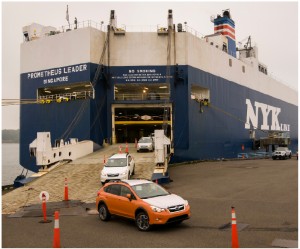 Volumes at Subaru's original ports such as Vancouver, Washington (above), have reached or surpassed the levels seen before new ports were added
Volumes at Subaru's original ports such as Vancouver, Washington (above), have reached or surpassed the levels seen before new ports were addedAccording to Jonathan Smith, port operations manager for Subaru at the port of Baltimore, stability in the carmaker’s scheduling is essential for vehicle processors to maintain a consistent workforce and increase the quality of installations. “We have people performing the same accessory functions consistently, which provides a good template for a high quality installation,” he says.
Subaru of America has also maintained a ‘built-to-order’ character in much of its order management. It has inventory stock in the US of fewer than 30 days and factory orders are sold out for about 45 days of production. The tight supply situation has made dealers adept at selling vehicles from the pipeline, says Lee.
Many orders are sold directly to final customers, especially for the newly launched Legacy and Outback, built at Lafayette. If a dealer does not have the car in the pipeline and cannot find it in a trade, he submits a sold order for which a customer pays a deposit, and waits. Such orders are prioritised, but wait times still range 30-75 days. “Sold orders help the turn rate, as once a car is processed and released for shipment or comes off a railcar, the dealer can see it in the system and call the customer to get ready,” says Lee.
A suite of IT systems integrates the order flow between Subaru of America, processors, logistic providers and dealers. It uses several Oracle systems to automate tracking, pay invoices and schedule processing.
“There is a big focus on scheduling in our systems,” says Mike Lupacchino, who spent the first half of his career at Subaru in IT. “Order info is sent to the port processor as an EDI file, so they also know which vehicles are a priority. It is then sent by ASN to the carrier for the railhead, so that when the carrier is building loads it sees which cars are sold and should be prioritised.”
 "We’re finding that carriers increasingly want to do shorter runs with more hauls, and so we try to use our growing volume to look at things like that"- Mike Lupacchino, Subaru of America
"We’re finding that carriers increasingly want to do shorter runs with more hauls, and so we try to use our growing volume to look at things like that"- Mike Lupacchino, Subaru of America
The high rate of pipeline and sold orders perhaps best came together for Subaru during the ‘cash for clunkers’ incentive scheme in the summer of 2009, in which the federal government paid a premium for customers to trade in older vehicles for new ones. The scheme offered the first sip of crisis relief to many brands, but for Subaru cash for clunkers was a "watershed”, says Lee. After launching new Legacy and Outback models earlier that summer, it sold substantially more vehicles compared to the same period in 2008. Dealers ordered vehicles from the plant order bank, swapped models, or checked what was at sea. Cars were rushed to meet the deadlines for the rebate.
The situation was repeated following the Japanese earthquake in 2011 and set the standard for Subaru’s current oversubscribed distribution. “The rate of sold orders on new models is currently very high,” says Lee. “Our turn rates are not quite ‘cash for clunkers’ efficient, but they are only a few points off.”
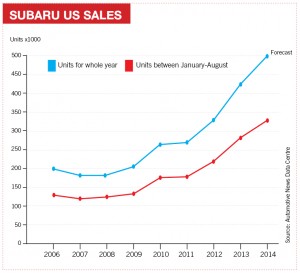 click to expand
click to expandSubaru’s tightly run order-to-delivery cycle is possible thanks to a common philosophy across its corporate sales planning, distribution and logistics management. It helps that Gerald Lee is responsible for all three.
Under Lee, the sales planning and analysis group creates the master ‘rollout’ document, which forecasts car line production, wholesale sales, retail sales, as well as dealer, port and in-transit inventory. Lee calls it Subaru’s “guiding light”, and it is updated at least once per month. Regional sales and corporate management teams try to live by it – although with recent growth around 20% year-on-year, the numbers have a tendency to fluctuate.
The planning group also works with Subaru’s sales zones and distributors on a monthly vehicle purchase order and allocation based on model, option, colour and emission specification. For Japanese plants, orders are for the next month’s production, while for Lafayette they are two months out. The August purchase order is therefore for September production in Japan and October in Lafayette. Delivery times are similar, around November.
Once the monthly allocations are set, dealers can view the full pipeline. Allocations come back to Subaru of America within three days with dealer assignments and accessory specifications. Those designated as sold orders are sent separately and given priority.
The purchase order and distribution plans are shared with logistics, which bases processing schedules and transport on them. The teams sit just a few doors down from each other, allowing them to integrate plans and schedules. “We reach out to the distribution team and they to us,” says Lupacchino. “We know what they are allocating and we work with them directly.”
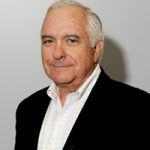 "I want our ports and logistics to be like the factory, [which] can’t churn out 50% more cars from one week to the next. I want our port processors to have the same workforce day in, day out"- Gerald Lee, Subaru of America
"I want our ports and logistics to be like the factory, [which] can’t churn out 50% more cars from one week to the next. I want our port processors to have the same workforce day in, day out"- Gerald Lee, Subaru of America
One sign the system is working well is the company’s accuracy for forecasted estimated time of arrival (ETA). According to Lupacchino, Subaru tracks a car’s ‘original ETA’, which is set when the car is first scheduled, and its ‘adjusted ETA’, which is modified based on variations in production or delivery. The original ETAs are critical, as dealers sell off of these dates.
Subaru is currently meeting 93% of its original ETAs on or before the forecasted date, despite the widespread rail disruptions across North America in the first half of 2014. Lupacchino says the rate is partly thanks to the level of sold orders and to the many Subaru models in short supply, since both get delivery priority. But he also credits Subaru’s network of truck providers. “Our truck carriers are doing great. The highest dwell time we see is currently four days from unloading,” says Lupacchino. “They are handling larger volumes really well, without increasing their damage rates.”
In it for the long haul
 Subaru has a careful allocation system, including prioritisation for vehicles sold to end customers, as well as vehicles in short supply
Subaru has a careful allocation system, including prioritisation for vehicles sold to end customers, as well as vehicles in short supplySubaru of America’s long-term relations with providers may have helped its trucking performance. The OEM avoids putting logistic services out to bid, instead using rolling, ‘evergreen’ contracts for as long as the quality is right, says Larry Strug. For example, Subaru has used Cassens out of Lafayette since the plant opened in 1989, while it has worked with United Road at the port of Vancouver for many years, before also bringing the provider to Richmond.
“We don’t change the carriers unless there is a real reason, such as a volume that we need to diversify or a performance issue,” says Lupacchino.
In many cases, Subaru seeks providers directly if it can find better economics and performance. For example, it approached the carrier PMTG after learning that the carrier was moving empty back from the midwest to Baltimore, which allows it to haul cars from Lafayette at a lower cost than rail transport, says Strug. More recently, Subaru went directly to US AutoLogistics (USAL) in Texas, and Champion in Albuquerque, New Mexico. “We go to the terminal people and find out who has least dwell time and who serves cars quickest,” Strug says. “It is in the rail or port processor’s best interest to get vehicles out of their terminals fast.”
 Subaru has made changes to carriers in cases where there has been performance or capacity issues. It switched to uses US AutoLogistics this year from its Texas railhead
Subaru has made changes to carriers in cases where there has been performance or capacity issues. It switched to uses US AutoLogistics this year from its Texas railheadThe stable scheduling and advanced planning also benefit providers. Jonathan Smith says WWL has gone to other customers with examples of Subaru’s scheduling process, including its EDI files and consistent hours. Carriers are also given advanced plans and encouraged to combine volume with other carmakers to complete loads.
However, Subaru has shown it will change providers if necessary. Earlier this year, it changed carriers at its Kansas City railhead after Cassens had transport issues. In Texas, the carmaker switched to USAL after it attributed rising dwell time to a lack of fleet investment to match Subaru’s growth at Waggoners (a company that United Road has since bought).
The company also looks to promote competition. Whereas Fleet Car once served Baltimore exclusively, Subaru later split the volume with PMTG. Similarly, Subaru started with only Selland in Richmond, but later added United Road and while it uses the port of Brunswick and a railhead 70 miles (115km) away in Jacksonville, Florida, the carmaker has divided volume between Proficient and the carrier Hansen & Adkins.
With its growth, Subaru has also added rail ramps that have made its trucking network more effective. New ramps include Jacksonville for volume out of Lafayette; Albuquerque from both Lafayette and Richmond; and St Paul, Minnesota from Vancouver. Subaru previously moved to these destinations by long-haul truck or from ramps further away. “We’re finding that carriers increasingly want to do shorter runs with more hauls and so we try to use our growing volume to look at things like that,” says Mike Lupacchino.
Negotiating rail: travelling first or second class?
Rail, of course, has been difficult for all companies this year in North America following the extreme winter weather and subsequent backlogs, with Subaru no exception. Dwell time and delivery KPIs have been “horrible”, says Lupacchino.
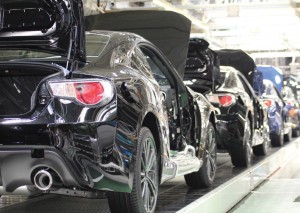 Subaru will expand production capacity at its plant in Lafayette, Indiana (above) from 250,000 to over 400,000 by 2016, which will change its logistics network
Subaru will expand production capacity at its plant in Lafayette, Indiana (above) from 250,000 to over 400,000 by 2016, which will change its logistics networkHowever, in contrast to some at other carmakers, Subaru executives insist they understand just how complex the rail issues have been. The western railways have perhaps struggled most because of the tough winter together with a huge demand for commodities like crops, coal and crude oil. Many of the destination ramps for Norfolk Southern (NS), Subaru’s rail provider from Lafayette, are terminals of western railways like BNSF.
“NS is a good provider out of Lafayette and we understand there are issues taxing the entire network,” says Strug.
The carmaker made some routing adjustments – vehicles moving by rail from Vancouver to Kansas City now take a southern route to avoid Chicago, for example – but tweaks only go so far. Strug points out that Lafayette is close enough to transfer its vehicles by truck to the ramps of other western railways should NS fail to get enough empty, multilevel railcars to Lafayette.
 "Rail in Lafayette will go from around 75 wagons per day between us and Toyota, to maybe 150 per day…We are watching to see what railroads do in the larger network, but also locally"- Larry Strug, Subaru of America
"Rail in Lafayette will go from around 75 wagons per day between us and Toyota, to maybe 150 per day…We are watching to see what railroads do in the larger network, but also locally"- Larry Strug, Subaru of America
Our rail contracts are coming up for renewal and we are debating whether we shouldn’t have a certain provision to truck to the western [rail]roads on a regular basis ,” says Strug. “That is a card we would rather not employ, but because of external events, we might have to.”
There have already been some shifts from rail to road and Strug is surprised at how effectively truckers have cleared ramps. Nevertheless, in the near future Subaru’s network is likely to need more rail, not less, he says. Subaru already has a mix that has served it well during the shortages, including moving by road from Lafayette to the northeast even as others move a similar route by rail. However, the upcoming production increases at Lafayette would likely open up rail destinations, such as Twin Oaks, Pennsylvania, or Seattle, Washington. A growth in exports from the US would also lend itself to rail.
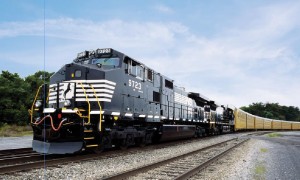 Despite difficulties with rail capacity this year, the expansion of production in Lafayette, together with increased exports from the US, are likely to require more rail transport in its network in the near future
Despite difficulties with rail capacity this year, the expansion of production in Lafayette, together with increased exports from the US, are likely to require more rail transport in its network in the near future“It would be hard to increase all the incremental production via truck delivery,” Strug says. “We are expanding the plant’s rail infrastructure for a change in our network, but with the current rail issues we have to monitor the situation carefully.”
Strug acknowledges that railways are spending record capital on projects such as triple-lining the northern tier of the BNSF network, but he is concerned about local tracks and terminals. Subaru is in discussion with NS about expanding rail infrastructure around Lafayette, for example.
“Rail in Lafayette will go from around 75 wagons per day between us and Toyota, to maybe 150 per day when we are at full capacity,” says Strug. “NS will need the infrastructure to process that. We are watching to see what railroads do in the larger network, but also locally in Lafayette.”
Gerald Lee admits carmakers may have to revise their expectations for rail services if they don’t want to compensate the railways for a premium service. Like Subaru, the railways currently have more demand than supply. While new vehicle sales have returned to 16-17m per year, both grain harvests and petroleum products shipments continue to be extremely strong along with other rail-shipped commodities. That means companies are competing for limited capacity and evaluating alternatives, he says. In response, Lee believes that, despite complaints from many carmakers, the railways are investing in people, equipment and infrastructure to increase their capacity and improve service levels.
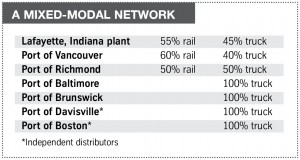 click to expand
click to expand“While I don’t want to see exorbitant cost increases for logistics, shippers need to be reasonable and encourage the capital flow into the automotive segment,” says Lee. “The question for automotive shippers is our priority ranking within the rail industry. Do we want to be number five in priority or close to number one?”
Getting paid in real time
Rail won’t be the only factor as Subaru expands. System investments are in the works, while the company expects IT upgrades from providers. Subaru is working on a system to streamline accessory parts ordering. It will also put increased emphasis on logistics in its processing scheduling, which today focuses more on days’ supply. “We don’t want to lose that [supply] emphasis, but we are hoping to see a decrease in the dwell time by a half day or so, on average,” says Lee.
Lupacchino and Strug want more real-time information from providers. While Subaru’s systems capture delivery milestones, there are gaps. For example, dealers pay carmakers once vehicles are shipped for final delivery, at which point dealers can retail the cars. However, the dispatch is not always reported promptly. A vehicle may leave a terminal on Monday morning, but some yards will wait until Tuesday to run a batch of updates. Similarly, carriers are not always fastidious in sending delivery proof, even though it processes their freight invoices and allows them to get paid.
"While I don’t want to see exorbitant cost increases for logistics, shippers need to be reasonable and encourage the capital flow into the automotive segment… [Does automotive] want to be number five in priority or close to number one?" - Gerald Lee, Subaru of America
“We sometimes get messages from dealers saying that they have received vehicles but they can’t get them drafted because the ramp hasn’t outgated them,” says Lupacchino.
“If this could be captured in real time, it would prevent financial delays.”
Moves towards electronic proof of delivery (ePOD) are encouraging, however a bigger development may be the arrival of telematics in Subaru vehicles in 2016, which could locate the exact position of any car. “You wouldn’t need ePOD if, down the road, the telematics system recognises the latitude and longitude of the dealership, wakes up and says ‘I’m here’,” observes Lee.
When a problem ain’t so bad
Like others, Subaru faces both macro and micro network questions, particularly around what will happen once its US plant is expanded and reaches full production capacity, but also the the wider import network as well. Honda has consolidated its northwest ports to Richmond, for example, which could put more strain on the vehicle carriers the carmaker shares with Subaru there. The labour pool available for port processors is a concern too (see box below), including where carmakers are increasing exports. Strug points out that as much as Subaru balances its processing and release scheduling, it suffers during the end-of-month dash anyway as other carmakers push out their volume and suck up capacity.
Overall, Subaru also continues to face limited inventory and surplus demand. While that puts pressure on logistics, it is a reality in which Subaru has thrived. “We have been in an excess demand situation since ‘cash for clunkers’. It is what we call a ‘high-grade problem’,” says Lee with a smile that suggests he has dealt with worse.
Subaru of America’s port processing is critical to its efficiency and profitability. As well as inspecting cars for final delivery, more than 200 accessories are added at ports, according to Jonathan Smith, port operations manager. These range from throw-in mats and cargo nets to complex installations such as spoilers, lighted exterior mirrors and performance exhaust systems. Doing this work at the port tends to be cheaper and more effective than doing it at dealers, and also frees up dealer service bays for retail and service work, says Gerald Lee, vice-president of vehicle planning and logistics.
Baltimore illustrates the services at Subaru’s ports. Its processor, WWL, manages a yard with capacity for 4,500 vehicles at Dundalk, a terminal owned by the Maryland Port Authority. WWL does accessory and PDI at a building now dedicated to Subaru, currently running on two shifts. In Baltimore, as at all of its ports, there is both a Subaru operations manager (Smith) to co-ordinate the processors and carriers, and a service manager to oversee accessory quality.
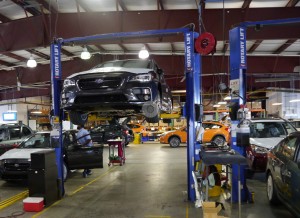 At Balitmore, vehicles are separated between 'drive through' for light accessory installation and 'heavy' for more complex accessories that might require a lift for work on exhaust systems, for example
At Balitmore, vehicles are separated between 'drive through' for light accessory installation and 'heavy' for more complex accessories that might require a lift for work on exhaust systems, for exampleThe local longshoreman’s union unloads vehicles from ships at Dundalk and parks them according to WWL’s plan. WWL employees carry out surveys and pre-delivery inspections. Afterwards, Subaru of America plans all processing tasks, detailing options and accessories, and scheduling vehicles based on sold priority, destination and inventory levels.
Vehicles move to separate staging areas as either ‘drive through’ for light accessories, or ‘heavy’ for complex installations. A ‘heavy’ install, for example, may require a lift to raise the car up for easier work. Once the work is finished, the vehicles are again inspected and WWL prints the Monroney label, which shows pricing including the added options. The vehicles are then released to carriers.
Subaru lets carriers build their own loads, so they have the option of combining different brands on their trucks. Baltimore volume is 100% truck delivery, served by Fleet Car and PMGT, and the terminal operates 24 hours per day, 365 days per year, with loading possible at any time.
Port in a labour storm
Subaru’s imports at Baltimore will be around 50,000 this year, close to the number it moved here before opening Brunswick, Georgia last year. However, space and labour are at a premium for the nation’s largest vehicle port. BMW recently joined Ford at a WWL processing centre in Dundalk, and both Honda and Toyota are also increasing exports from the terminal, which impacts distribution, says Smith.
Furthermore, Dundalk has strict security, which is good for cargo, but can be prohibitive for attracting workers. Anyone entering the terminal needs a Transportation Worker Identification Credential (TWIC) and WWL will not interview candidates if they don’t have it. Many potential applicants won’t risk the $150 investment, which is not required at the port’s private terminals.
A big concern is a 1m sq.ft (93,000 sq.m) Amazon warehouse under construction next to the port on the site of a former GM plant, which will employ at least 1,000 people full time. “Everyone is wondering how it will impact labour forces. It is not easy to get good, talented people,” admits Smith.
Subaru and WWL will have to find ways to retain or acquire labour at the port. It won’t be easy, but Baltimore, like other Subaru ports, is strategic for the carmaker. “Accessories are a profit centre for Subaru and our ports are the final assembly line,” says Gerald Lee. The best talent mustn’t slip into the sea.









